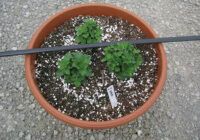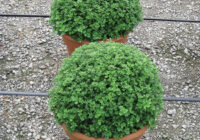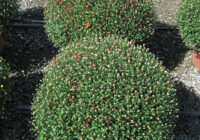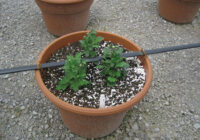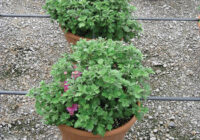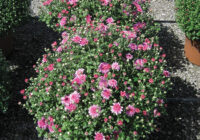
Features
Crop Culture
Flowers
Lighting
PGRs
How to prevent premature flowering in garden mums
Garden mum cuttings typically arrive at a tough time of the year when producers are busy with spring crops. How does one set up for more punctual flowering? Cutting suppliers weigh in.
March 28, 2022 By Mark Smith, Rick Rabb and Will Healy (with intro by Melhem Sawaya)
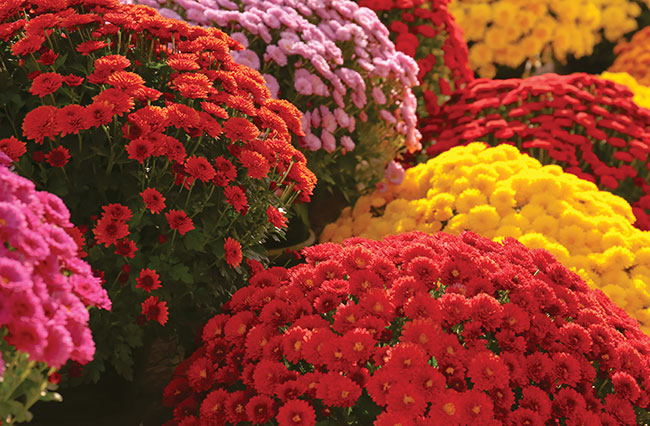
Garden mum crops usually start with vegetative cuttings from stock plants grown in Florida or California. Because growers receive these cuttings during their busiest time of the year when they are preoccupied with spring production and shipping, mum propagation usually takes second or third place in terms of attention. This leads to less-than-suitable growing conditions for starting garden mums, and we end up trying to correct the mistakes made during propagation and growth.
Through all my years of growing plants, I find that giving the plant what it needs at the right time leads to a successful crop with fewer challenges. Ignoring knowledge or not applying it on time will lead to financial loss and frustration. The irony is that these mistakes happen time after time, and we do not do anything to change them.
This year I asked three of the main suppliers of garden mum cuttings to share their knowledge on how to prevent premature flowering, with the hopes that we can pay more attention in the spring so we can produce a great garden mum crop. The following is the information they shared. Read and apply as needed.
~Melhem Sawaya, Focus Greenhouse Management
 Mark Smith,
Mark Smith,
Chrysanthemum Technical Lead,
Syngenta Flowers North America
Garden mums can be induced to flower using short day lengths and cool night temperatures. Understanding these two environmental factors and how to control them are key to getting your garden mums off to a good start.
Day Length: Day length is the most common way to manipulate flowering in chrysanthemum, but the critical day length needed to cause flowering is often misunderstood. Although we typically suggest using blackcloth to create a 12-hour nighttime period to induce flowering in the summer, garden mums will start down the flowering path with day lengths much longer than 12 hours. This is proven every year with natural flowering garden mums in late August and early September. In controlled tests that we have performed, it was possible to get some garden mum varieties to flower under 14.5-hour day lengths. This means that early flowering garden mums will try to set flower buds when grown under natural day lengths in April and most of May. Even though natural day length is longer than 12 hours, it is still not long enough to prevent flower bud initiation until the end of May and June for growers in Canada.
Night Temperature: Growers on the West Coast and at higher altitudes can flower garden mums in the summer without using blackcloth. Even though the natural day length is long enough to prevent flower bud initiation, consistent night temperatures at or below 16 °C will cause the plants to set buds and flower. These same temperatures are common for growers on the East Coast when moving plants outside in late May and early June, and the plants will start to respond in the same way by setting buds and stalling initial growth.
Solutions
It is imperative to manage the environment when starting your garden mum crop because natural conditions are not always enough to ensure vegetative growth. Setbacks in vegetative growth early on will create significant issues for the rest of the crop as you try to restart the plants and make up for lost growing time. When you notice that your varieties have come into flower too early and have been too small in the past, you likely need to make some adjustments in how you start your crop.
Lighting: The tried-and-true method for manipulating day length is the use of night interruption lighting for mums. Lighting works for all varieties in all areas of North America, regardless of the time of year when you want vegetative growth. The target light level is 10 ftc or 2 µmol/m2/s. This is the minimum light level needed to prevent flower bud set, including the darkest spots in the crop. Check your light levels in the corners and between bulbs at plant level, not just the area directly underneath the bulb. In the past, 100-watt incandescent bulbs spaced out on 3-meter centres would give enough light for the plants. With compact fluorescent bulbs that have lower wattage, more bulbs are required to achieve the same light levels. Spacing bulbs 1.5 meters apart on the light line and placing light lines 3 meters apart (as was done for incandescent bulbs) will work. Many growers have installed LED light systems that are also highly effective, but they require more specific understanding of the area in which they will be used, as opposed to a general guideline for all.
Night interruption lighting is recommended in propagation for any mum crop throughout the entire year. It is generally easy to set up when the plant density is high and the total space needing lights is not so great. Once the cuttings are rooted and transplanted, the lit area will need to increase by quite a bit, especially if you move to final spacing at transplant. If you are moving outside at time of transplant, setting up lights for outdoor production can be a bit more complicated. Planning for proper natural day length at time of transplant is likely the best way to avoid photoperiod issues after propagation. For standard 3.0 quart /2.8 litre pots, simply scheduling transplants to start in mid-to-late June will allow the plants to experience long enough natural day lengths. For larger containers that need more grow time, try sticking cuttings in a 50-cell or 36-cell tray, or even 9 to 11 cm pots. These trays/pots are easier to hold in the long day propagation area and allow the cuttings to continue growing before transplant. When ready, transplant these bigger liners into the final containers in mid-to-late June when the natural day lengths are long enough to prevent flower initiation.
The plant growth regulator Florel (Ethephon) can be used as a tool or as insurance when you need vegetative growth under marginal natural day lengths. Typical spray rates of 500 ppm every 10 to 14 days, up until seven to nine weeks before flowering (depending on the variety), will help keep the plants growing vegetatively. However, when plants are under significant photoperiod pressure (less than ~13-hour days), the Florel will not be enough to overcome the photoperiod stimulus for flowering.
Temperature: With chrysanthemum, it is generally recommended that growers maintain night temperatures above 18.5 °C for vegetative growth – and even better if it stays above 20 °C. Just as with photoperiod adjustment, this is relatively easy to do in the propagation area since you need heat for good rooting. But after transplant, maintaining night temperatures can be more challenging. We can follow the same thoughts as noted before for photoperiod so the plants are in a good temperature environment. Avoid the coldest of night temperatures by planning your transplant in mid-to-late June for the earliest crops. Or, if you are in an area that typically gets a cold spell in late June, develop a plan to start transplanting in July—many growers do this today. Larger propagation cells for larger containers and earlier flower crops allow for a later transplant date. If you have had issues with premature budding in the past, you might be surprised at how much bigger your garden mums can be by transplanting one or two weeks later and avoiding the low night temperatures that your plants were exposed to before.
Florel can be a beneficial tool for unexpected cool nights once the plants are moved outside. Watch for the long-range forecast and be prepared for a Florel spray when you see that there will be multiple nights in a row with night temperatures below 16.5 °C. We would not expect a budding issue after a single cool night, but once there are several in a row or close to each other, the plants may start to think about flower initiation. Florel is a preventative solution, so it needs to be applied before the cool nights occur for best results. That is why monitoring the long-range forecast is important. Applications can be repeated every 7 to 14 days, depending on the forecast.
Keep in mind that Florel is also a growth retardant. When it’s being used to prevent flower bud initiation due to marginal natural day length or cool night temperatures, you will need to adjust your growth regulator program to compensate for the Florel effect early on in the crop. You can also add some gibberellic acid to the Florel spray tank to help offset the growth retardant effect.
Not all buds become flowers
When starting your garden mums, the last thing to keep in mind is that not all buds are flower buds. Every chrysanthemum will set a “bud” once a certain number of leaves have been formed on the shoot. These buds are known as “long day leaf number buds” as they will appear even under 24-hour mum lighting. Unless the growing shoot has been exposed to cool nights or short days, this type of bud will never develop into a flower and will not prevent the overall vegetative growth of your plants. Although the buds may look similar to a flower bud, there are no petals inside, and they will feel hollow. Once the long day leaf number bud has set, apical dominance is released, the side branches will start to grow, and the bud will end up being covered by new growth. The number of leaves needed for this kind of bud to develop is very variety dependent. Some will develop these buds more quickly than other varieties. The Jacqueline family of chrysanthemums is a great example of this, quickly setting a long day leaf number bud but continuing to grow without flowering.
Understanding and properly adjusting the growing environment is a grower’s best tool in preventing premature flowering. By avoiding natural day lengths that are not long enough and night temperatures that are too cool, growers can ensure continued vegetative growth. This can be accomplished by adjusting the growing schedule to start the plants at a better time of year for vegetative growth, or by keeping plants inside where the environment can be manipulated when the natural conditions are less favourable. Florel plant growth regulator can be a helpful tool to help bridge the gap between the manipulated environment and proper natural conditions.
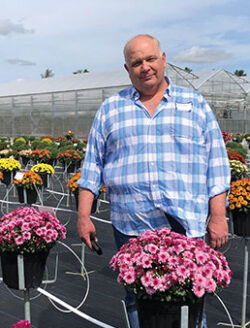 Rick Rabb
Rick Rabb
Technical Support Specialist,
Dümmen Orange
Fall garden mums are planted during the longest days of the year to flower naturally from the end of August thru September. By the time we complete our spring season, some consider garden mums one of the easier crops to grow but there are a few items we need to pay attention to. Prebudding is one of them. It causes uneven growth, and uneven flowering is something we can prevent.
There are a number of factors that can cause prebudding. Day length and temperature are the largest contributors. Water stress and delayed planting can also add to the problem.
Day length: Garden mums, like poinsettia, pot mums and kalanchoes are short day plants. We really should refer to them as long night, since the length of night is the critical measurement. In the case of garden mums, buds initiate with 14 to 15-hour day lengths. This means that photoperiod bud initiation can occur in April, May and even early June. This is resolved by providing night interruption lighting from 10pm to 2am. For natural season flowering, this night interruption is critical during propagation and thru the month of June.
Temperature: Warm temperatures during propagation and after planting are important. Garden mums can root at cooler temperatures but it is important to keep them very vegetative; this is accomplished by rooting at a minimum of 21°C. Once rooted, the liners must remain above 18°C to prevent the unwanted prebud. Once planted, it is just as important to maintain night temperatures at 18°C thru the month of June even though we can be tempted to turn off our heating systems at this time. Remember, consecutive nights below 16°C will initiate the flowering process.
Stresses: Water stress and delayed planting can also lead to unwanted early bud initiation. Garden mums are quick to root and need to be planted to keep them in a vegetative growing state. Delayed planting can happen for a number of reasons such as pot, soil and labour shortages. When you delay the planting of a liner, you are placing extra stress on the garden mum cutting. The liner becomes root bound and can go through numerous unwanted dry down cycles. This will slow down your desired growth, and the extra stress on the liner will cause another opportunity for prebuds to form. Consider using a larger cell for propagating. For example, use a 32-cell instead of a 102. This will allow a more flexible planting window and allow the garden mums to grow and start to branch even before planting.
One other area where prebudding can initiate is the time right after transplant. Ensure the roots get off to the best possible start in the new container. Make sure the garden mums are properly watered in. Often, garden mums are placed directly under drip after planting. While this is a great timesaver, extra attention must be made to ensure that the liner has been watered in properly! If proper contact between the liner and the potting soil is not made, the liner roots can dry out, setting back growth by days. In some instances, the liner will never recover.
Taking these factors into consideration, the following are the minimum requirements to prevent prebudding on garden mums:
- Provide long days in propagation until planting time. Night interruption preferred.
- Root garden mums at 21°C and prevent the liner from dipping down to temperatures below 18°C .
- Avoid severe dry down of liners and during the first weeks after transplant.
Florel is another available tool to help keep garden mums vegetative. A good starting point is one application of Florel at 500 ppm, one week before planting. Florel should not be used instead of cultural recommendations; it should be used in conjunction with them to provide insurance against prebudding. Remember, if the garden mum has formed a bud, Florel will not remove it. If all the culture-related steps are taken, then Florel is not required. My experience is that even one application of Florel will change the flower date slightly. As always, trial first.
 Will Healy
Will Healy
Senior technical and research manager (retired),
Ball Horticulture
Mums are ‘thermo-periodic,’ which means that flower initiation occurs when both temperature and photoperiod are optimized. Crown budding is the response to incomplete flower initiation due to marginal or incomplete induction conditions. In other words, crown buds form when the induction treatment is too short to complete initiation. Garden mum crown budding is easy to understand and control if you understand what triggers flower initiation.
- When night temperatures are between 18-27°C (65-82°F), plants are induced to flower by short days. This is the classic response seen in pot and cut mums.
- Night temperatures lower than 18°C (65°F) can induce plants even under long days while temperatures above 27°C (82°F) inhibit flowering even under short days. This is the response in early spring due to cold nights and ‘heat-delay’ under short day treatments from July to September.
- Garden mums are a 5 to 7-week response group, which makes them VERY sensitive to temperature.
North American stock plants are primarily grown in Florida where URCs harvested prior to June may experience several sub-18°C (65°F) night temperatures during the March to April period. When the URCs are harvested from more mature stock, the incidence of crown budding can be more severe. URCs harvested after mid-May experience night temperatures greater than 18°C (65°F) and crown budding is seldom observed. Random crown budding occurs due to the variability from season to season, coupled with stock maturity.
When finished growers root the URCs without heat and the night temperatures are below 18°C (65°F), then crown budding can occur regardless of long day conditions. It is critical that rooting occurs at 20-24°C (68-76°C) night temperatures along with long days to minimize induction – this is especially critical for pre-June rooting periods! Aggressively fertilizing the liners is essential to keeping the plants growing vegetatively when conditions are optimal for crown budding to occur. An application of Florel (Ethrel) can inhibit crown budding if applied BEFORE crown buds are visible.
Once the liners are transplanted, feed aggressively, minimizing high soil EC conditions. Use 20-20-20 or 20-10-20 which are less salty than a high nitrate-based fertilizer. Avoid moving outside when the night temperatures are below 15°C (60°F) for several days, since this will promote crown budding in the spring when the photoperiods are still marginally long. If crown buds appear after transplant, don’t despair! The newer varieties have vigorous basal branching which will over-grow the crown buds if the plants are aggressively fertilized.
The period from July 20-Aug 5 is critical as hot nights prior to and during this period will result in big plants and delayed flowering. Conversely, several cool nights in this same period can result in crown budding, small plants and early flowering. The more sub-18°C (65°F) nights that occur in the July 20 to Aug 5 period, the more crown budding and smaller plants there are due to rapid flowering.
Print this page
